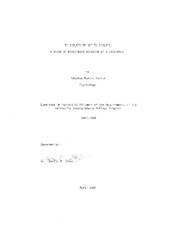| dc.contributor.advisor | Stoup, Charles M. | |
| dc.creator | Farrar, Stephen Martin | |
| dc.date.accessioned | 2022-06-30T15:59:56Z | |
| dc.date.available | 2022-06-30T15:59:56Z | |
| dc.date.issued | 1984 | |
| dc.identifier.uri | https://hdl.handle.net/1969.1/CAPSTONE-FarrarS_1984 | |
| dc.description | Program year: 1983-1984 | en |
| dc.description | Digitized from print original stored in HDR | en |
| dc.description.abstract | This study was conducted to investigate the effects of a law-violating model, presence of a uniformed authority figure, and the combination of both of these factors on the likelihood of violating a "Don’t-walk" signal by pedestrians. A total of 2219 pedestrians were observed. The results indicate that the presence of a law-violating model increases the likelihood of violation, while the presence of an authority figure decreases this likelihood. It was also found that with both present simultaneously, the rate of violation was no different from control. Additionally, the gender of the model and authority figure was varied, and the effects of this variation on male and female pedestrians observed. | en |
| dc.format.extent | 39 pages | en |
| dc.format.medium | electronic | en |
| dc.format.mimetype | application/pdf | |
| dc.subject | pedestrians | en |
| dc.subject | law-violating model | en |
| dc.subject | uniformed authority figure | en |
| dc.subject | gender | en |
| dc.subject | crosswalks | en |
| dc.title | To Violate or Not to Violate: A Study of Pedestrian Behavior at a Crosswalk | en |
| dc.type | Thesis | en |
| thesis.degree.department | Psychology | en |
| thesis.degree.grantor | University Undergraduate Fellows | en |
| thesis.degree.level | Undergraduate | en |
| dc.type.material | text | en |


